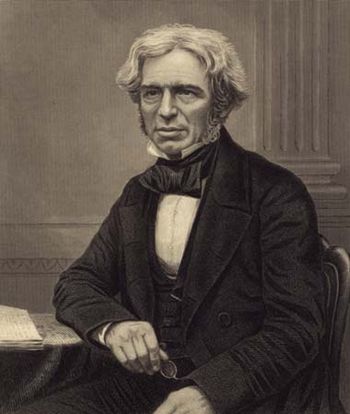Michael Faraday
Claimed by skalathoor6
Michael Faraday was an English scientist who's discovery's greatly influenced the field of electromagnetism.

Biography
Farady was born in London in 1791 to a poor family, meaning he only received a basic education. He got a job as a bookbinder's apprentice at age 14, where he would read books on scientific subjects to teach himself a wide array of topics. Faraday furthered his career by contacting the chemist Humphry Davy to become his chemical assistant in 1813. With Davy, Farady traveled around Europe meeting other famous scientists and fine-tuning his own ideas for research. When Farady and Davy returned in 1815, Faraday continued performing experiments and conducting research, making many crucial discoveries and starting programs such as the Royal Institution's Friday Evening Discourses and Christmas Lectures, which still continue to this day. Faraday's health started to deteriorate in the 1840's, which lessened his ability to do further research. He died in 1867. The farad, a unit for capacitance, is named in his honor.
Discoveries
Faraday's contributions to modern science lie mainly in the field of electromagnetism and electrochemistry. He discovered the relationship between electricity and magnetism, called electric inductance, which can be defined by an equation known as Faraday's Law. He also discovered diamagnetism, where materials oppose applied magnetic fields with their own fields, invented the first electrical motor, and electrolysis, where electricity drives chemical reactions. Among other things, Faraday also discovered the molecule benzene and popularized terms like cathode, anode, and ion, which are used in everyday chemistry today.
Major Contributions to Physics
Faraday's Law of Magnetic Inductance
One of Michael Faraday's greatest discovery's is magnetic inductance, or the relationship between a changing magnetic field and a voltage. Basically, any change in a magnetic field near a coil in a wire will cause a voltage to run in that coil. That change in magnetic field could be a change in field strength or simply a change in position of the field relative to the coil. The formula is [math]\displaystyle{ emf = -N{\frac{d{Φ}}{dt}} }[/math], where emf is the induced voltage, N is the number of loops in the coil, and Φ is the magnetic flux. Magnetic flux is defined as [math]\displaystyle{ Φ = BA }[/math], where B is the magnitude of the magnetic field, and A is the area of the loop. Flux is any measurable field through a surface. Any time there is a change in magnetic flux with respect to time across the coil, a voltage is induced in that coil, causing current to flow.
Diamagnetism
Another of Faraday's important discoveries is diamagnetism. Diamagnetic materials oppose an applied magnetic field with a weak, induced magnetic field of its own. The material does this by alligning its electron clouds in such a way that the current of those electrons creates a magnetic field in the opposite direction of the applied field. All materials have diamagnetic properties. Conductors are actually strong diamagnets, as they induce strong opposing magnetic fields.
Connectedness
- The most obvious connection Michael Faraday has to Physics II is the applications of Faraday's Law.
History
Put this idea in historical context. Give the reader the Who, What, When, Where, and Why.
See also
Are there related topics or categories in this wiki resource for the curious reader to explore? How does this topic fit into that context?
Further reading
Books, Articles or other print media on this topic
External links
Internet resources on this topic
References
This section contains the references you used while writing this page